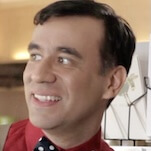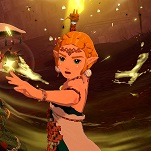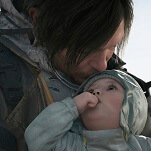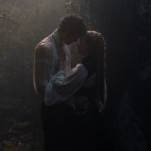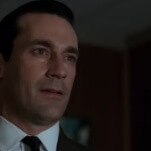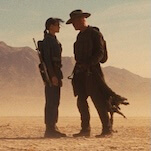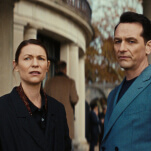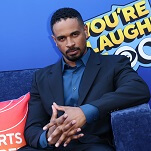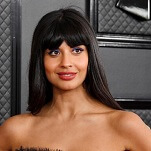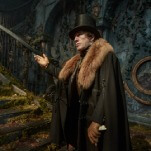2016 is the year of Faith Herbert at Valiant Comics. The publisher has been steadily raising her profile since the conclusion of Harbinger two years ago, and she’s become one of Valiant’s most popular characters since gaining her own solo miniseries, the first for a plus-sized superheroine. Faith (Valiant) has received a lot of attention in the press because of the character’s physical appearance, but her size plays no part in Jody Houser’s story, which instead focuses on how Faith’s personality distinguishes her from Valiant’s other heroes.
Optimistic, compassionate, and cheerful, Faith loves being a superhero. There’s nothing torturing her, and while she’s certainly had her share of pain, she doesn’t wallow in it. For Faith, the good things in life far outnumber the bad, and many of those good things come from nerd culture. Faith feels like a direct response to the “fake geek girl” label. She is instead a woman who takes pride in her “nerdy” interests and never has to defend why she loves what she loves. That love of entertainment is the driving force behind the best moment in Faith #4: a speech Faith delivers to a group of Hollywood players who are actually undercover aliens plotting the end of humanity.
Faith tries to get the Vine plantings to spare humanity by saying that the work of these people on Hollywood property has made them a part of humanity via the stories they create, stories that have a profound impact on the people that absorb them. “You’re telling human stories!” Faith says. “Stories that make people laugh and cry and think. Stories that are there when we need them the most. Stories helped make me who I am. Made me want to be a hero. They’ve shaped so many of us.” These words are paired with a flashback to Faith as a young girl, finding solace in a comic book with a Wonder Woman-like character on the cover after the death of her parents, and it’s the main instance where Houser delves into some deeper narrative content.
It’s fitting that this speech features art by Marguerite Sauvage, who has contributed only a few pages to each issue but who has quickly become the definitive Faith Herbert artist at Valiant. Her vibrant artwork fits the tone of the story and the character especially well, and her imaginative layouts and bold color choices make her pages stand out in the midst of the more generic artwork from Francis Portela and colorist Andrew Dalhouse. Portela and Dalhouse are totally competent, but Portela’s figures can be very stiff at times and Dalhouse’s colors get muddy, particularly during the fight sequence in issue #4, which is dominated by a sickly green palette.
Houser’s story isn’t necessarily trying to reinvent the wheel with Faith, hitting a lot of the standard solo superhero beats with small twists like Faith’s secret identity falling apart almost immediately, but it would be nice to see a more distinctive artist like Sauvage in charge of the artwork. Sauvage is sticking with Faith as the character gains her own ongoing series in July, while Portela will be replaced by Pere Perez, who did great work on DC’s Stephanie Brown Batgirl series before jumping over to Valiant. Hopefully, Sauvage will play a larger part in the visuals moving forward, because Faith flies highest when she’s in her hands. [Oliver Sava]
Thanks to titles like
Saga,
Southern Cross, and
Empress, there’s no shortage of science-fiction comics out right now, but one niche that is largely empty is true all-ages sci-fi comics. With
Joyride #1 (Boom! Studios), that lack has been filled, if only for a four-issue run. With titles like
Giant Days and
Jonesy on its roster, not to mention tie-in books for shows like
Adventure Time and
Fraggle Rock, Boom! has a good handle on what makes a book appealing for everyone without boring adults or depicting themes that might not be ideal for young readers.
Joyride is, at its heart, the story of two young people running away from home. In their case, Uma and Dewydd are running away from a shadowy, tyrannical government, but they’re ultimately still kids trying to escape into a world of more freedom. By the end of this first issue, there’s little specific information the readers know about the world that Uma and Dewydd are leaving behind, but the characters and their writ-large motivations are firmly planted. Dewydd wants the freedom that Uma believes she can get them, but he doesn’t like the risks she’s taking to get them there. Uma skews close to being a manic pixie dream girl, but her competence and drive set her apart from the weaker parts of the trope. It’s clear she would be doing this without Dewydd if she needed to. Fans of comics like Brian Q. Miller’s Earthward will enjoy Joyride, and there’s just enough of a nostalgic Zenon feeling to appeal to fans of a certain age.
Nearly the entire Joyride team has worked together before in some capacity or another. Writers Jackson Lanzing and Collin Kelly worked with artist Marcus To on Hacktivist. Lanzing and Kelly also contributed to several issues of Batman & Robin Eternal. The newcomer to the team is colorist Irma Kniivila, who’s worked on a few issues of Captain Canuck, as has To. The fact that To, Lanzing, and Kelly have worked together so closely in the past lends Joyride a sense of ease and professionalism. These three men, along with Kniivila and veteran letterer Jim Campbell, know how to make visually pleasing comics that draw the eye from page to page. There are several large panels and double-page spreads that display To’s talent for massive scale and scope. Although his characters and expression work are stellar, he can reveal quite a bit to readers when he pulls back for wider shots. With this well-oiled team, an interesting and appealing idea, and characters that are familiar enough to be immediately compelling yet different enough to feel fresh, Joyride starts a lot stronger than many other #1s. [Caitlin Rosberg]
Reprinted with a lovely new cover by Annie Mok, Sophie Campbell’s
Wet Moon Volume 1: Feeble Wanderings (Oni Press) reintroduces the series of graphic novels that she began more than 10 years ago. Here begins the story of Cleo, Trilby, Audrey, and Mara, a loose-knit group of friends who are struggling through college in the titular town of Wet Moon. Fans of Campbell’s current work on
Jem And The Holograms will recognize her distinct aesthetic, though her older work isn’t quite as refined as it has become in recent years.
The hallmarks of her style are already in place with Wet Moon, though, and Campbell excellently balances lushly textured moments of hyper-detail with looser and more stylized images. Her characters—nearly all of them women—are provided singular physical qualities. Campbell deserves all the praise she’s gotten for the diversity of her characters’ bodies. Cartoonish in style, their bodies still have a mass to them, and each character carries herself in a distinct, deeply human way. Simple, elegant lines convey hints and hollers of fleshy lumps peeking over the waistband of a pair of panties. Hair, every strand delineated and defined, refuses to stay put, disheveling with each movement of a head. Lips are pouty, soft, and pierced with rings and studs. There is a particularity to each character—from her height, hair, and face to her posture and body type. Campbell makes her compositions feel lived-in and real.
The same can be said of the narrative, which, reading as deeply contemporary, anxiously rests under a double-edged sword of Damocles. The story’s concerns are quotidian, Campbell quietly tracking the daily lives of this group of women as a new semester of college is set to begin. Dotting and detailing this world are outfits, hairstyles, technologies, and cultural references that situate Feeble Wanderings squarely in the mid-’00s, and it effectively dates the work. There are downsides to this, and only time will tell if it ages well. There are, however, current upsides.
Contemporary comics’ greatest failing is their inability to relate to the modern condition. They can feel disconnected from the world their readers live in, their lack of immediacy resulting in a flat and vacuous read. It’s difficult to care about a recent release that obstinately refuses to acknowledge its cultural context. Campbell, on the other hand, is able to tell a story with a clear sense of narrative and visual depth, a sense of place and purpose. In many ways, Feeble Wanderings looks like a work of self-edification; readers can see Campbell honing her cartooning style as the book goes on. It’s also a work that, for better or worse, readers might see themselves and their world in. [Shea Hennum]
If you make a habit of reading the weekly newspaper of a medium-sized city, there’s a good chance you’ve already encountered the work of Kaz. His
Underworld strip has been a fixture of the format for 24 years. It’s also the recipient of a new retrospective anthology,
Underworld: From Hoboken To Hollywood (Fantagraphics), which cherry-picks the best of the strip to present a remarkably consistent view of the artist’s work.
Kaz—short for Kazimieras G. Prapuolenis—is an alumnus of Raw and Weirdo who has spent much of the last two decades working in television animation, winning an Emmy for his work on Cartoon Network’s Camp Lazlo. But his “day job” working on series like SpongeBob SquarePants and Phineas And Ferb hasn’t affected his stripwork. On the contrary, his cartooning appears to inform his animation work. Although he never wavers from a strict four-panel structure, his cartoons remain flexible in terms of subject matter and tone. Kaz lacks the congenital spleen of fellow alt-weekly mainstay Tony Millionaire. His work, while scabrous and occasionally offensive, is rarely mean-spirited. More to the point, Underworld is possessed by a sense of anarchy that prevents the material from growing stale or one-note. Bawdy sex jokes commingle with more heady existential material, and inside-baseball cartoonist humor alternates with the occasional political gesture.
Throughout the strip, Kaz’s most frequent characters are Snuff and Creep Rat, distended versions of Popeye and Mickey Mouse. The one constant in their shifting landscape is that they appear cheerful even in the face of disgusting adversity. It’s a dark world but the inhabitants never seem to falter, responding to even the most disastrous setbacks with aplomb. Other characters share this seeming inability to admit defeat against crushing humiliation. If there is one unifying feature to all the disparate kinds of gags strung across the years, it’s just that—an underlying resilience that defies an inherently cruel world. In that respect, it’s not hard to draw a line between Creep Rat and SpongeBob, the only real difference being the frequency of masturbation jokes.
In a strip entitled “Cartoon RX,” Creep Rat lies in the hospital with an IV hanging out of his arm. Speaking with a doctor, he urges, “Give it to me straight, Doc. I can take it.” The doctor replies, “You’re dead.” Creep, terrified, suggests, “How about with a little sugar coating?” To which the doctor replies, “Darling, you’re dead.” In another strip, Creep is seen walking in the wilderness: “Going out to the woods to kill myself again.” There’s a silent panel with Creep walking through the forest. Then, realizing, he says, “Wait a minute, I don’t have a gun or a knife or a rope or anything!” Finally, he sits down to weep: “Wah!! I’m so stupid I deserve to live!” Ain’t that always the way of it? [Tim O’Neil]





